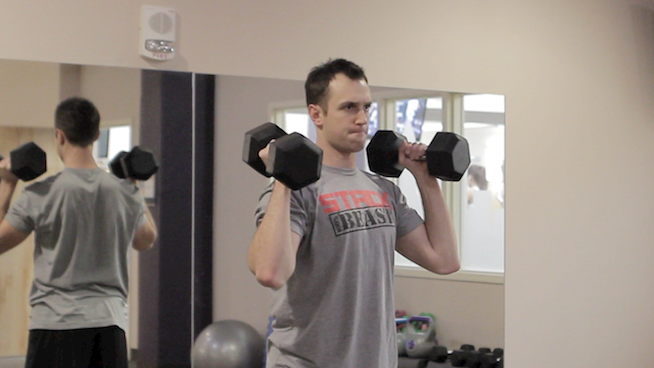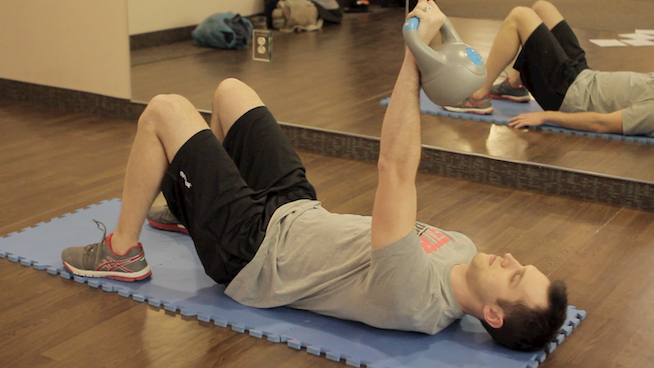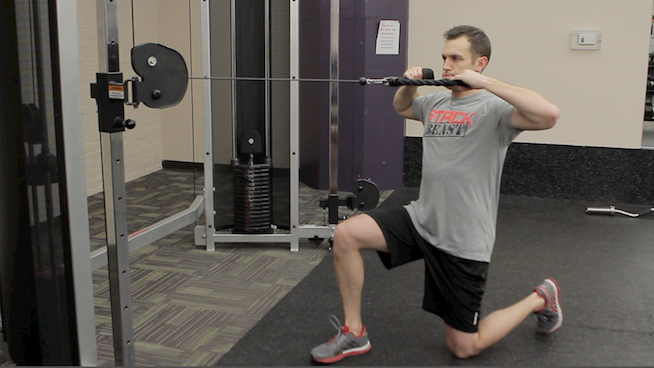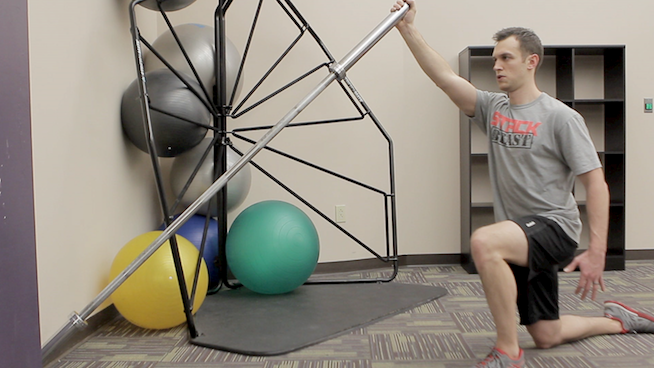7 Exercises That Safely Build Shoulder Strength
The shoulder is one of the most sensitive joints in the body. It has incredible range of motion, allowing athletes to throw a baseball or swing a racquet. However, its support structure relies primarily on muscle and connective tissue.
The shoulders of athletes who participates in overhead sports like baseball, tennis or football (QB) can experience serious wear and tear. Small muscles and tendons can impinge. Support structures can wear out.
That’s why you need to be careful when you work out your shoulders. You need to strengthen your shoulders, but in a way that won’t cause damage, and ideally will prevent injury while improving your performance.
Here are seven shoulder-strengthening exercises that you can perform safely and effectively.
Neutral-Grip Overhead Press

Pressing overhead is generally considered a no-no for anyone at risk for a shoulder injury. This holds true for the Military Press and the Dumbbell Overhead Press, which externally rotate the shoulders. Anatomically, this puts you in a vulnerable position and increases the chance of experiencing pain or causing an injury—especially if you’re a pitcher, quarterback, tennis player or any other overhead athlete.
However, we can’t just ignore the delts, which this type of exercise does a great job of training. To accommodate your shoulders, Tony Gentilcore, co-founder of Cressey Sports Performance (Hudson, Massachusetts) and an expert on training baseball players, recommends slightly altering the exercise by using a neutral grip so your palms face each other.
Gentilcore explains, “A neutral grip tends to be a bit more shoulder friendly because there’s a little more space or wiggle room within the acromial space.” This is where impingements or injuries to the rotator cuff often occur.
Kettlebell Shoulder Packing

Many of the exercises you perform, including Push-Ups and Bench Presses, work the frontside of your shoulders. So it’s not uncommon for athletes to overdevelop the front of their shoulders and neglect the backside.
According to Brandon McGill, director of performance at STACK Velocity Sports Performance, this can create a problem, because when throwing or hitting a ball or swinging a racquet, a weak backside of the shoulder cannot slow the arm down. “The brain knows it can’t put on the brakes and therefore won’t let speed exceed braking capacity,” McGill explains.
To fix this imbalance, McGill has his athletes perform Kettlebell Shoulder Packing, a move that trains the backside of the shoulder and creates ideal posture for your shoulder to work in. Ultimately, having a strong backside of the shoulder will help you perform your skills at higher speeds, because you can control the movement.
Bottoms-Up Kettlebell Press

On the other hand, many athletes can do overhead exercises, but they do them wrong. They don’t engage their rotator cuff and shrug their shoulders, causing instability.
The Kettlebell Bottoms-Up Press fixes this. According to Mike Boyle, co-founder of Mike Boyle Strength and Conditioning (Woburn, Massachusetts), holding the kettlebell in the bottoms-up fashion automatically engages your rotator cuff, because your shoulder is fighting to control a side-to-side motion.
Boyle says, “You can have someone who says, ‘my shoulder hurts when I press overhead,’ and you can give them the Bottoms-Up Kettlebell Press and they’ll look at you like it’s magic.”
Face Pulls

Mike Reinold, a renowned physical therapist, recommends Face Pulls to develop the backside of the shoulder. When you pull toward your face, your shoulders do the majority of the work, rather than your back.
It’s a versatile move you can perform with a cable or resistance band. You can do it as a warm-up exercise or later in your workout as a strength move. Keep your shoulders down and back when pulling. There’s a tendency to shrug during this exercise, which encourages bad posture.
Pallof Press

The muscles in your shoulder directly impact its health and performance. The same goes for core exercises, which provide a solid foundation for your shoulders.
The Pallof Press works both. McGill says, “While not strictly a shoulder exercise, the Pallof Press improves shoulder stability while keeping the core braced.”
To make the exercise more specific to your shoulders, McGill recommends holding each rep for three seconds. When you return to the starting position, pull your shoulders down and back, and hold that position for three seconds.
Single-Arm Landmine Press

Some athletes have mobility limitations, such as tight lats or an immobile t-spine, causing their back to arch and their ribs to flare out as they lift overhead. If you fall into this category, you shouldn’t lift overhead—even if using a neutral grip. It’s something you have to earn the right to do.
Fortunately, the Single-Arm Landmine Press allows you to still work your shoulders in this manner. “It’s important for athletes to get overhead and be able to upwardly rotate their shoulder blades,” says Gentilcore. “The compromise is the Landmine Press.”
By lifting at an angle rather than straight over and keeping a controlled range of motion, you put the shoulder in an optimal position to work. And it takes any mobility issues out of the equation.
Floor Press

If you’re a heavy shoulder user or you’re dealing with a shoulder injury, the Bench Press is not the best option for you. Even when done correctly, benching heavy weight at full range of motion can be tough to handle.
That’s why Reinold likes the Floor Press, which he says safely develops the frontside of the shoulder. What makes it different from the traditional Bench? The floor limits how much your shoulders have to move. “It’s relatively safe and more applicable to a wide range of shoulders, because you can’t go too deep,” Reinold says.
READ MORE:
5 Rear Delt Exercises for Strong, Stable Shoulders
The 8 Most Dangerous Exercises for Your Shoulders
No Gear? No Problem! Try These Bodyweight Shoulder Exercises
Do Good Mornings to Build Back and Hamstring Strength
See the Best Core Exercises for Athletes
RECOMMENDED FOR YOU
MOST POPULAR
7 Exercises That Safely Build Shoulder Strength
The shoulder is one of the most sensitive joints in the body. It has incredible range of motion, allowing athletes to throw a baseball or swing a racquet. However, its support structure relies primarily on muscle and connective tissue.
The shoulders of athletes who participates in overhead sports like baseball, tennis or football (QB) can experience serious wear and tear. Small muscles and tendons can impinge. Support structures can wear out.
That’s why you need to be careful when you work out your shoulders. You need to strengthen your shoulders, but in a way that won’t cause damage, and ideally will prevent injury while improving your performance.
Here are seven shoulder-strengthening exercises that you can perform safely and effectively.
Neutral-Grip Overhead Press

Pressing overhead is generally considered a no-no for anyone at risk for a shoulder injury. This holds true for the Military Press and the Dumbbell Overhead Press, which externally rotate the shoulders. Anatomically, this puts you in a vulnerable position and increases the chance of experiencing pain or causing an injury—especially if you’re a pitcher, quarterback, tennis player or any other overhead athlete.
However, we can’t just ignore the delts, which this type of exercise does a great job of training. To accommodate your shoulders, Tony Gentilcore, co-founder of Cressey Sports Performance (Hudson, Massachusetts) and an expert on training baseball players, recommends slightly altering the exercise by using a neutral grip so your palms face each other.
Gentilcore explains, “A neutral grip tends to be a bit more shoulder friendly because there’s a little more space or wiggle room within the acromial space.” This is where impingements or injuries to the rotator cuff often occur.
Kettlebell Shoulder Packing

Many of the exercises you perform, including Push-Ups and Bench Presses, work the frontside of your shoulders. So it’s not uncommon for athletes to overdevelop the front of their shoulders and neglect the backside.
According to Brandon McGill, director of performance at STACK Velocity Sports Performance, this can create a problem, because when throwing or hitting a ball or swinging a racquet, a weak backside of the shoulder cannot slow the arm down. “The brain knows it can’t put on the brakes and therefore won’t let speed exceed braking capacity,” McGill explains.
To fix this imbalance, McGill has his athletes perform Kettlebell Shoulder Packing, a move that trains the backside of the shoulder and creates ideal posture for your shoulder to work in. Ultimately, having a strong backside of the shoulder will help you perform your skills at higher speeds, because you can control the movement.
Bottoms-Up Kettlebell Press

On the other hand, many athletes can do overhead exercises, but they do them wrong. They don’t engage their rotator cuff and shrug their shoulders, causing instability.
The Kettlebell Bottoms-Up Press fixes this. According to Mike Boyle, co-founder of Mike Boyle Strength and Conditioning (Woburn, Massachusetts), holding the kettlebell in the bottoms-up fashion automatically engages your rotator cuff, because your shoulder is fighting to control a side-to-side motion.
Boyle says, “You can have someone who says, ‘my shoulder hurts when I press overhead,’ and you can give them the Bottoms-Up Kettlebell Press and they’ll look at you like it’s magic.”
Face Pulls

Mike Reinold, a renowned physical therapist, recommends Face Pulls to develop the backside of the shoulder. When you pull toward your face, your shoulders do the majority of the work, rather than your back.
It’s a versatile move you can perform with a cable or resistance band. You can do it as a warm-up exercise or later in your workout as a strength move. Keep your shoulders down and back when pulling. There’s a tendency to shrug during this exercise, which encourages bad posture.
Pallof Press

The muscles in your shoulder directly impact its health and performance. The same goes for core exercises, which provide a solid foundation for your shoulders.
The Pallof Press works both. McGill says, “While not strictly a shoulder exercise, the Pallof Press improves shoulder stability while keeping the core braced.”
To make the exercise more specific to your shoulders, McGill recommends holding each rep for three seconds. When you return to the starting position, pull your shoulders down and back, and hold that position for three seconds.
Single-Arm Landmine Press

Some athletes have mobility limitations, such as tight lats or an immobile t-spine, causing their back to arch and their ribs to flare out as they lift overhead. If you fall into this category, you shouldn’t lift overhead—even if using a neutral grip. It’s something you have to earn the right to do.
Fortunately, the Single-Arm Landmine Press allows you to still work your shoulders in this manner. “It’s important for athletes to get overhead and be able to upwardly rotate their shoulder blades,” says Gentilcore. “The compromise is the Landmine Press.”
By lifting at an angle rather than straight over and keeping a controlled range of motion, you put the shoulder in an optimal position to work. And it takes any mobility issues out of the equation.
Floor Press

If you’re a heavy shoulder user or you’re dealing with a shoulder injury, the Bench Press is not the best option for you. Even when done correctly, benching heavy weight at full range of motion can be tough to handle.
That’s why Reinold likes the Floor Press, which he says safely develops the frontside of the shoulder. What makes it different from the traditional Bench? The floor limits how much your shoulders have to move. “It’s relatively safe and more applicable to a wide range of shoulders, because you can’t go too deep,” Reinold says.
READ MORE:
5 Rear Delt Exercises for Strong, Stable Shoulders
The 8 Most Dangerous Exercises for Your Shoulders
No Gear? No Problem! Try These Bodyweight Shoulder Exercises
Do Good Mornings to Build Back and Hamstring Strength
See the Best Core Exercises for Athletes










